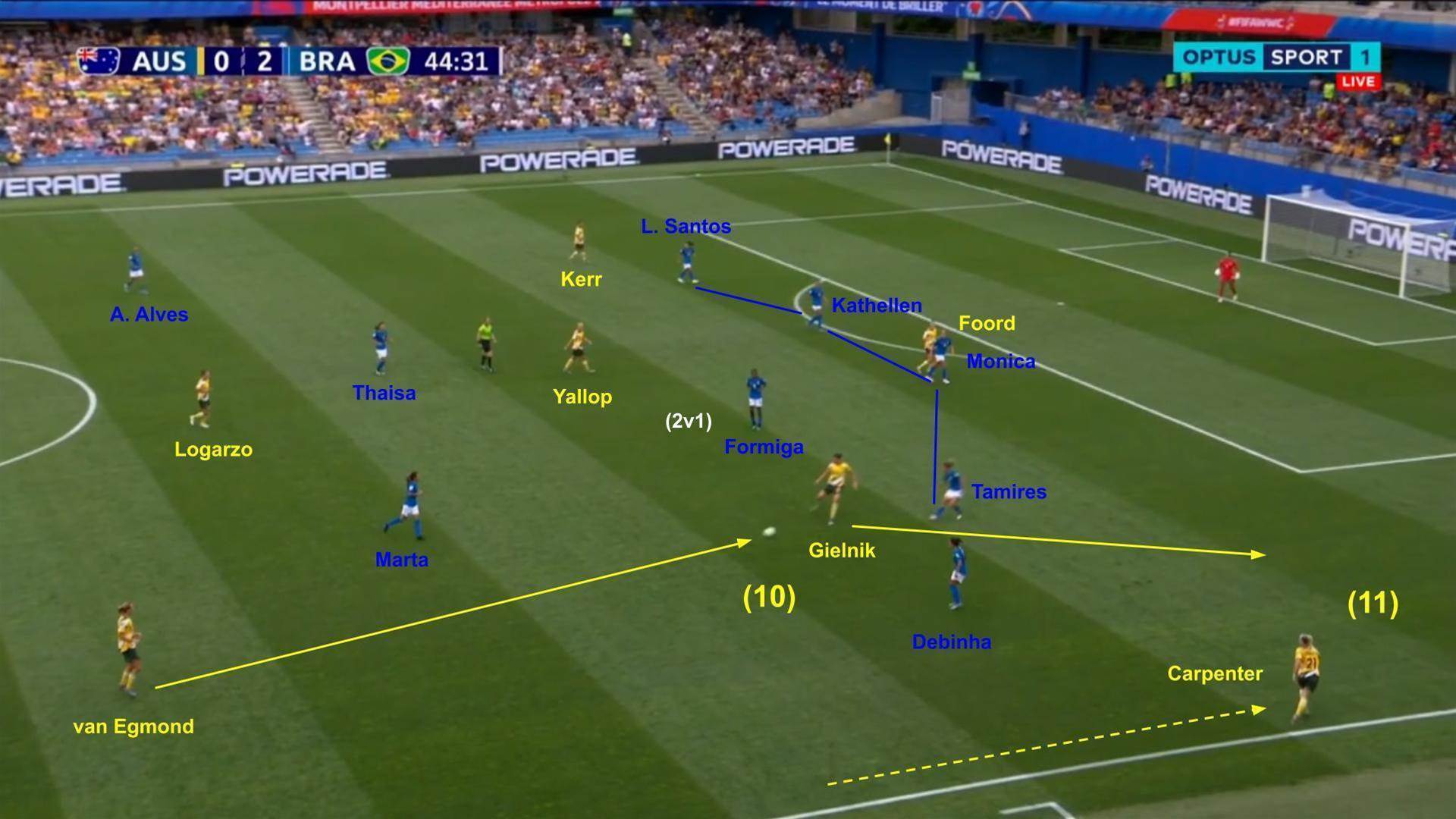Australia entered the tournament thin on options at centreback.
Australia’s high defensive line
In the aftermath of Australia’s opening round defeat to Italy, a large (and arguably unfair) amount of the criticism was centred on the high positioning of the Australian defensive line.
While Polkinghorne and Kennedy’s relative lack of pace meant that they didn’t look entirely comfortable defending with a high line, they were effective at catching the Italians offside on several occasions, and it shouldn’t be forgotten that it was two individual errors of judgement that cost Australia the win.
On the whole, the high line largely worked by allowing Australia to compress the midfield zone in defensive phases, and this continued here against Brazil. As shown in the photo below, the distance between the ball carrier (8) and the defensive line (9) is no more than 20 metres.
 For all their technical gifts, Cristiane, Marta, Andressa Alves, and Debinha aren’t particularly quick, and so it made sense for Australia to risk leaving space in behind for the reward of keeping them far away from goal.
For all their technical gifts, Cristiane, Marta, Andressa Alves, and Debinha aren’t particularly quick, and so it made sense for Australia to risk leaving space in behind for the reward of keeping them far away from goal.
With the quicker Catley at centreback, Australia’s defence also looked much more comfortable holding their line higher, as Catley’s speed allowed her to get across and recover any balls played in behind.
In the second half, Brazil brought on Ludmila, who offered far more pace than Marta (but far less technical quality), and with Catley’s pace Australia were able to keep her quiet.
Carpenter great going forward, but Brazil exploit defensively
Australia’s system relies on their fullbacks Ellie Carpenter and Kellond-Knight to create 2v1 overloads down the wings, working combinations in wide areas with their respective wingers to get into crossing positions.
As against Italy, Carpenter was particularly attack-minded, and her frequent overlapping caused problems for Brazil. For example, in the photo below Gielnik (10) has moved into the space outside of Formiga (similar to how Logarzo and Yallop enjoyed a 2v1 overload) to flick van Egmond’s pass into an overlapping Carpenter (11).
 Carpenter’s strengths in getting forward offset her defensive weaknesses, which in fairness is typical of most young fullbacks in the modern game. While a tenacious defender 1v1, Carpenter’s defensive concentration and positioning can be inconsistent.
Carpenter’s strengths in getting forward offset her defensive weaknesses, which in fairness is typical of most young fullbacks in the modern game. While a tenacious defender 1v1, Carpenter’s defensive concentration and positioning can be inconsistent.
Notably, Brazil attacked more down their left side (i.e. Carpenter’s side), with left back Tamires far more attack-minded than opposite fullback Leticia Santos, and it was Tamires’ cross that led to the penalty for Brazil’s first goal.
For the second goal, Debinha exploited the positioning of Carpenter to run in behind her and cross for Cristiane to score. In this instance, it was Carpenter (and van Egmond) caught ball watching rather than moving to close space.
It’s also interesting to note that in the previous game, Italy also concentrated most of their attacks down Carpenter’s side. Time will tell whether this is because opposition coaches have identified Carpenter’s side as an opportunity, although it is safe to say that the defensive aspects of her game will improve with experience.
Related Articles

'Timing not right': Montemurro's verdict on Matildas vacancy

Matildas: 'Fourth at the Olympics is honestly the worst place you could come'
.jpg&h=172&w=306&c=1&s=1)












